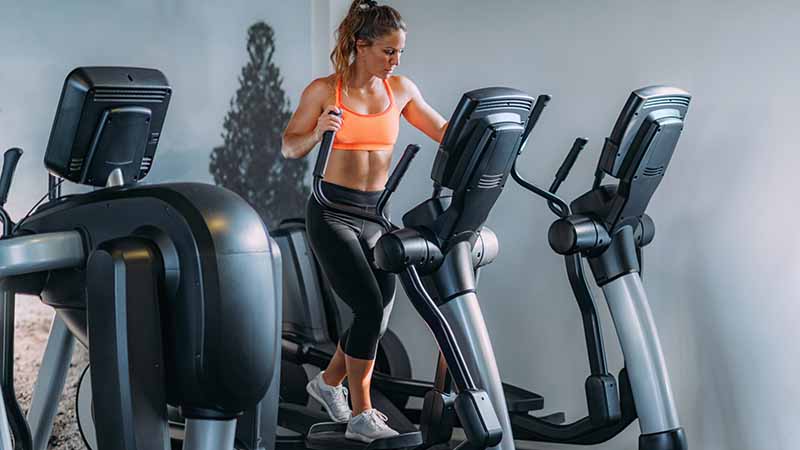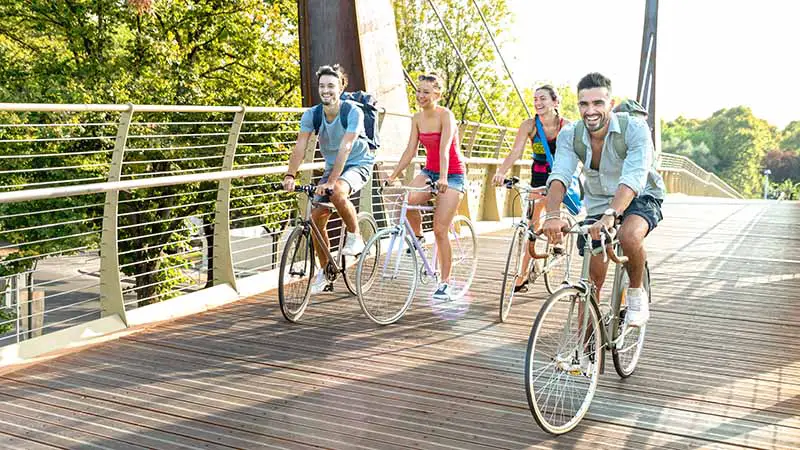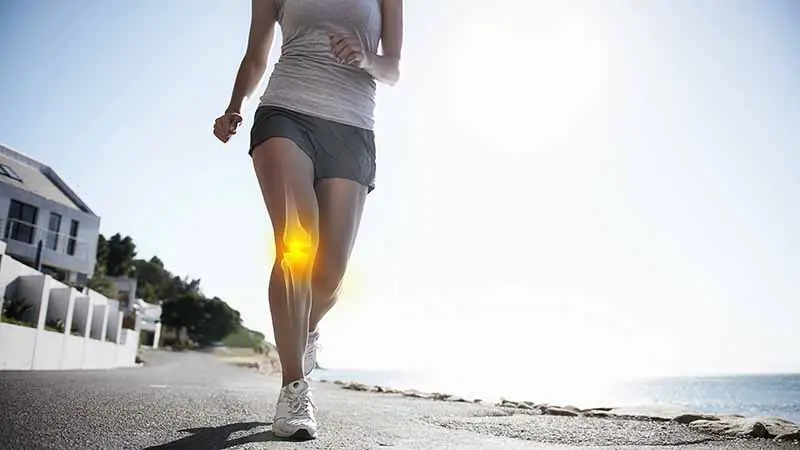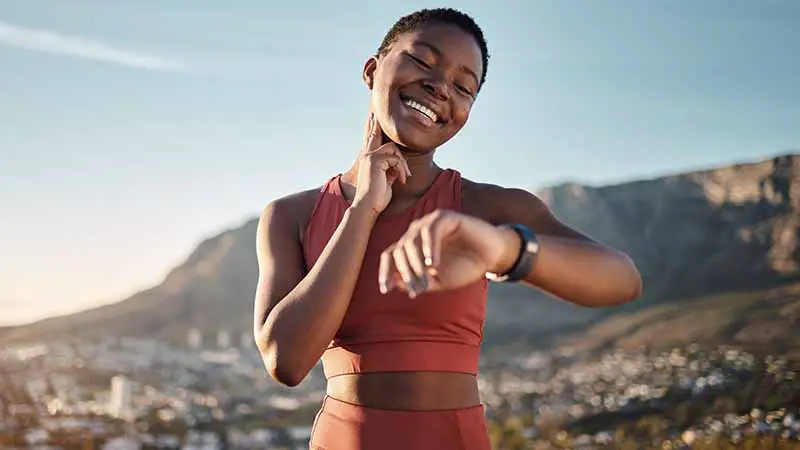Contents
Can Biking Help With Running
Both biking and running are great outdoor (primarily) cardiovascular aerobic activities that you can do at various speeds, distances, and intensities.
As both types of athletes are constantly looking to improve their strength, endurance, and overall fitness levels, there are various ways in which biking can help improve one’s running.
As with any sport or athletic activity, too much of one specific form of exercise can impede your performance and can lead to injuries.
For those who like to run 5-6 times per week, incorporating a day of biking into your schedule will help improve different aspects of your running training.
In addressing the question at hand, can biking help with running, the answer is yes.
While it is true that cycling will not mimic the eccentric load that runners experience, it will help you with your cardiovascular fitness and other aspects of personal health.
1. The Importance Of Cross Training

Cross-training for runners as with any other athlete is vital for a successful, healthy, and injury-free lifestyle.
Whether you mix in biking, swimming, yoga, or strength training, they will all help you improve your running PRs.
Regardless of what type of runner you are, be it an experienced high-volume one or one who is returning from an injury or even a newbie, cross-training for any type of sport or athletic activity will more than likely result in positive performance results.
As an alternative outdoor exercise, runners who add cycling into their workout schedule will find improved fitness, endurance, stamina, and performance levels.
2. Complementary Muscles
Running, as with any sport or activity, requires building up certain groups of muscles that perform specific movements and functions.
While this is fine initially, there will come a time in which your body and performance will plateau, potentially causing frustration and a lack of improved results.
When runners add cycling to the mix, the movement requires muscles such as your glutes, quads, hamstrings, calves, and core to function differently.
This will help complement the muscles that are used to make you a stronger, faster, more explosive runner.
As runners place a lot of stress on their calf muscles, specifically the soleus during their mid-foot strike action, it is a similar motion to when cyclists place the balls of their feet on the center of the pedal.
When a cyclist stands up out of the saddle to pedal, the calf muscles are activated to stabilize the foot.
3. Similar Movement
When addressing muscle activation while cross-training as a cyclist and as a runner they are relatively similar. This is key when dealing with body position and movement.
When pedaling out of the saddle, it is important to keep your body as vertical as possible, similar to that in which you run. This is also key when you consider mimicking the first strike position with your legs and feet.
4. Recovery Day

Every athlete and every workout needs an active recovery day or two built into their schedule to avoid not only physical fatigue but also mental. Runners are no different.
However, that doesn’t mean crashing on the couch all day (though there is a time and place for that as well).
When your legs are sore from pounding the pavement (or track), a low-impact and low to medium-intensity level ride will assist your legs in their recovery.
By increasing the blood flow to your main lower body muscle groups (glutes, quads, hamstrings, calves), it will help flush out any lactic acid buildup and begin the repairing process.
In addition, the pedaling motion will help to ease joint stiffness and muscle soreness, which will help get you back on your feet faster than if you took a complete day off.
5. Low Impact
For runners who deal with knee or foot damage, the constant pounding can take a toll on your body. Cycling provides you with a non-weight-bearing option.
Whether you choose to hop on a spin bike or take a cruise on a local trail or bike path, biking allows you to continue working your lower body muscles without the wear and tear on key body parts such as your feet, knees, and lower back.
6. Prevents Injury

While seated, pulling the pedal upwards (assuming you are using cycling boots or clips as the foot needs to be in a horizontal position), the movement engages the tibialis anterior (shin muscle).
This is especially true when biking uphill. By strengthening your shin muscles, it may prevent shin splints which is a common injury for runners.
Most running injuries come from the overuse of muscles because of the lengthy time of pounding on your feet and knees.
Using an alternative such as cycling provides runners with a similar aerobic workout without the same fatigue and breakdown of form.
7. Increases Aerobic Capacity / Improves Aerobic Training
There are a variety of ways that runners can use cycling for aerobic training, challenging the body to work hard for various durations demanding that it adapts quickly to what is being asked, and ultimately strengthening it.
Whether you choose to work on power and speed by pedaling out of the saddle for short sprints or set out on a long journey at a steady pace to help build endurance, the use of a bicycle gives runners a great alternative for their aerobic training needs.
By altering the level of the gears and changing the cadence, riders can vary the intensity of their muscle usage and heart rate.
One of the largest organs that both cyclists and runners use during their workouts or competitions is their lungs.
Most runners do not run the distance of a half or full marathon each time they head out, but by replacing those running sessions with a long-distance bike ride, it will help build their cardiovascular system.
8. Improves Cadence
When calculating your running cadence, it is simply the number of steps/strides you take per minute. According to Anthony Luke, M.D., M.P.H and the founder of RunSafe, the ideal cadence for runners is between 170-180 SPM.
By incorporating bike workouts into your training, it can assist with improving your leg turnover rate while helping to increase your heart rate, which combines to increase your cadence rate.
Health Benefits

Having a happy and healthy heart not only makes daily living that much easier but also provides the following benefits for both cyclists and runners.
- Strengthens heart muscles
- Improves lung health and capacity
- Stimulates blood circulation
- Reduces the level of fat in the blood
- Lowers resting heart rate
- Reduced risk of cardiovascular disease and cancer
- Improved recovery rate following exercise
Biking Workout Programs for Runners
For biking to help with running and to gain maximum results from their cycling workout, there are a few important factors that they should implement.
Riding Tips
Riders should make sure that they set their seat at a height that allows their legs to go through a full range of motion without overextension.
Similar to the “triple extension” angle of the knee while running, the ideal bending point should be approximately 145 degrees.
Using clips or cycling shoes will allow for a true pedaling motion rather than relying on one leg pushing the pedal downward.
Brick Workout
Used by duathletes and/or triathletes, this style or workout has you riding at a steady rate of exertion (approximately 5-6 out of 10) for an hour ride and then hop off your bike and immediately (after changing your shoes if needed of course) run hard for 10-15 minutes or 2-4 miles.
This short and intense workout will allow you to push through having tired legs without having to worry about the constant pounding on the body.
Recovery Workout
As mentioned, cycling is a great recovery workout option for runners who are dealing with some aches and pains or to reset the mind and body.
Going on a flat road ride (or using a stationary bike), focus on pedaling at no less than 95 RPM and a 60-80% threshold heart rate.
Benefits of Biking and Running
As two of the most popular cardiovascular exercises in the world, both cycling and running have their benefits and advantages.
While some may argue that one is better than the other, engaging in whichever one makes you the happiest and suits your lifestyle the best is the one that is right for you. And should you choose to engage in both, then hats off to you!
- Both cyclists and runners can get a workout either outdoors or indoors
- Both forms of exercise allow you a mental release
- Both are relatively easy to do at either the lowest or highest form of exertion
- Both are great calorie-burning activities
- Both allow you to explore new locations either where you live or where you travel
